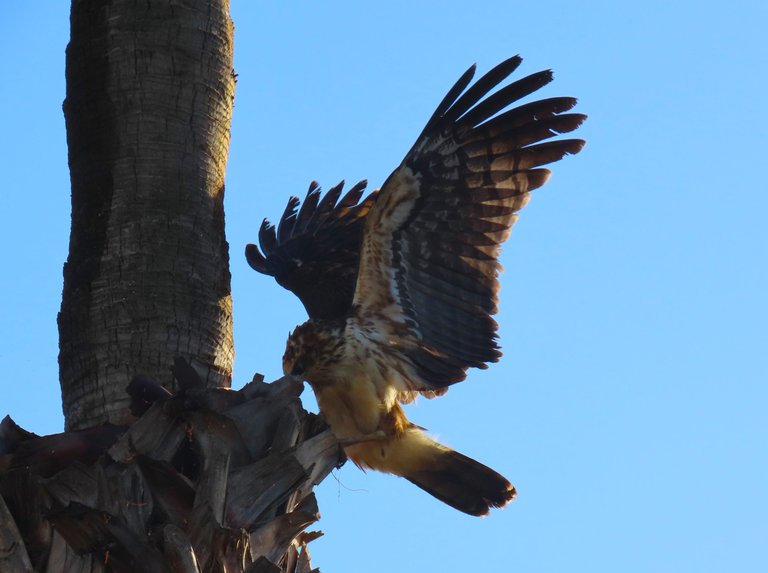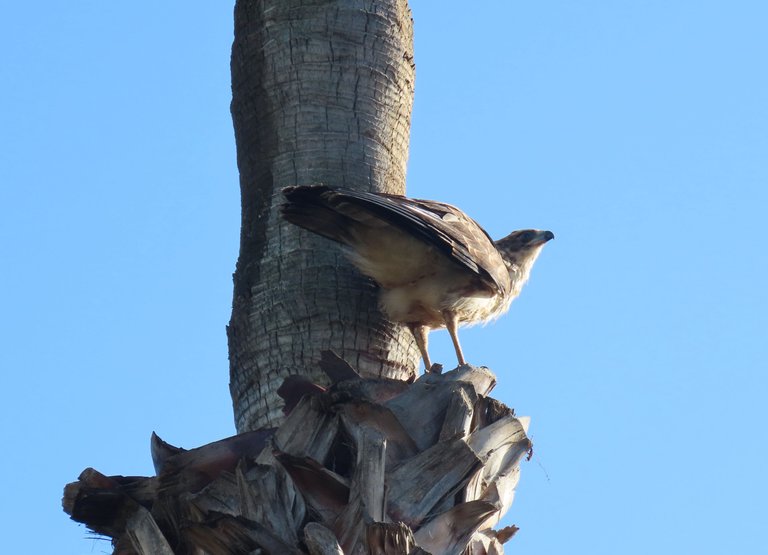A fascinating experience that held me spellbound.
Not every day that you will see something like this.
A juvenile African Harrier Hawk (Polyboroides typus) was scratching around for rodent nests on the husks of a high palm tree trunk.
I know that they sit hidden in a big tree to watch for the movements of birds preparing nests and other animals that might have youngsters. Even small dogs are not secure when the hawks are around, and I have had a few innings with them already. But I have not seen this before, as the hawk worked its way around the flat top husks on the trunk of a high palm tree.
You will see that Junior is still a bit inexperienced, as the rodents saw his landing and they must have scattered lower down in the husks.
I will show you step by step about his abortive attempts to capture prey.
Let me take you back to the start, as I saw the hawk flying past and landing on the husks of a tree, as you can see below.
Then he started to inspect the top of the husks.
Carefully, as a strong wind was up.
Now let's watch to see if he could get anything.
Scratching away and hoping to find something.
Here below is some more information about the African Harrier Hawk.
The African harrier-hawk, harrier hawk or gymnogene (Polyboroides typus) is a bird of prey. It is about 60–66 centimetres (24–26 in) in length. It breeds in most of Africa south of the Sahara. The only other member of the genus is the allopatric Madagascar harrier-hawk (Polyboroides radiatus).
The African harrier-hawk is a medium-sized raptor. The upperparts, head and breast are pale grey. The belly is white with fine dark barring. The broad wings are pale grey with a black trailing edge fringed with a narrow white line. The tail is black with a single broad white band. There is a bare facial patch of variable colour, usually red or yellow. Sexes are similar, but young birds have pale brown instead of grey, and dark brown replacing black. An unusual trait of this species is the double-jointed ankles it possesses, which enable it to reach into otherwise inaccessible holes and cracks for prey. A comparable leg-structure and behaviour can be found in the Neotropical crane hawk as well as the extinct Australian Pengana; a case of convergent evolution.
Huh! scratching again, but still with no luck.
He turned to scratch from the other side, but we both looked up, as we heard the call.
A parent came over high up and it was sending out a loud call.
Junior didn't hesitate, as he took off immediately.
And so, my adventure ended, but I was a very happy chappie for being allowed to witness this show. I cannot tell you how happy I get when a scene like this appears. Nobody got hurt and it was all pure magical. I have posted Harrier Hawks before, even a post where a hawk sticks its head into a gap of a house roof, as they are supreme hunters of prey. The harrier hawks also have the ability to climb trees, as they have double jointed ankles. We see nature as a serene and slow-paced setting but let me tell you that things can happen in an instant, and if one is not alert and ready with a camera, then some great opportunities go abegging.
Such is life.
I hope you have enjoyed the pictures and the story.
Photos by Zac Smith-All Rights Reserved.
Camera: Canon PowershotSX70HS Bridge camera.
Thank you kindly for supporting this post.













Just a magnificent looking bird and agree it is magical looking. I did enjoy the pictures for sure.
Thank you, and I am glad that you see it my way. Happy also that you enjoyed the pictures.
A !BEER and !PIZZA for you.
$PIZZA slices delivered:
papilloncharity tipped coinjoe
wrestlingdesires tipped papilloncharity
@papilloncharity(4/15) tipped @pranavgtd
papilloncharity tipped wrestlingdesires
Junior is going to learn fast - unless Mom and Dad spoil him 🤣 What awesome pictures :)
!PIZZA !ALIVE !LOL !PIMP
This post has been manually curated by the VYB curation project
You must be killin' it out here!
@wrestlingdesires just slapped you with 1.000 PIMP, @papilloncharity.
You earned 1.000 PIMP for the strong hand.
They're getting a workout and slapped 1/1 possible people today.
Read about some PIMP Shit or Look for the PIMP District
He knows what he is looking for but does not have the technique right yet. Thank you and it was a real adventure:))
!PIZZA !LOL !WINEX !LUV
A photograph shows an eagle laboring in the tree to feed its young. Your photographs are beautiful as always. @papilloncharity
Oh yes, the birds are very active in their attempts to get food, as it is winter here now.
Glad that you liked photos.
!PIZZA
What a beautiful bird! I guess that's how we all learn, trial and error. Even true in the animal kingdom! Great pictures, very well done! Even here in the US one must be careful with small dogs, some golden eagles will try to scoop them up!
You can say that again, as that is a real handsome bird. As it is in nature, just so it is in life, as we all were juniors once. Thank you.
Our eagles are scarce in winter, but thankfully the hawks are active, and I think that small dogs are in danger in many countries with big birds.
!BEER
View or trade
BEER.Hey @thebighigg, here is a little bit of
BEERfrom @papilloncharity for you. Enjoy it!Learn how to earn FREE BEER each day by staking your
BEER.Keep up the good work. 👏
You are loved. 🤗 + u deserve the best. 💪
Curated by Mystic artist Gudasol
Interested to to help me spread more positivity (musically) on Hive?.